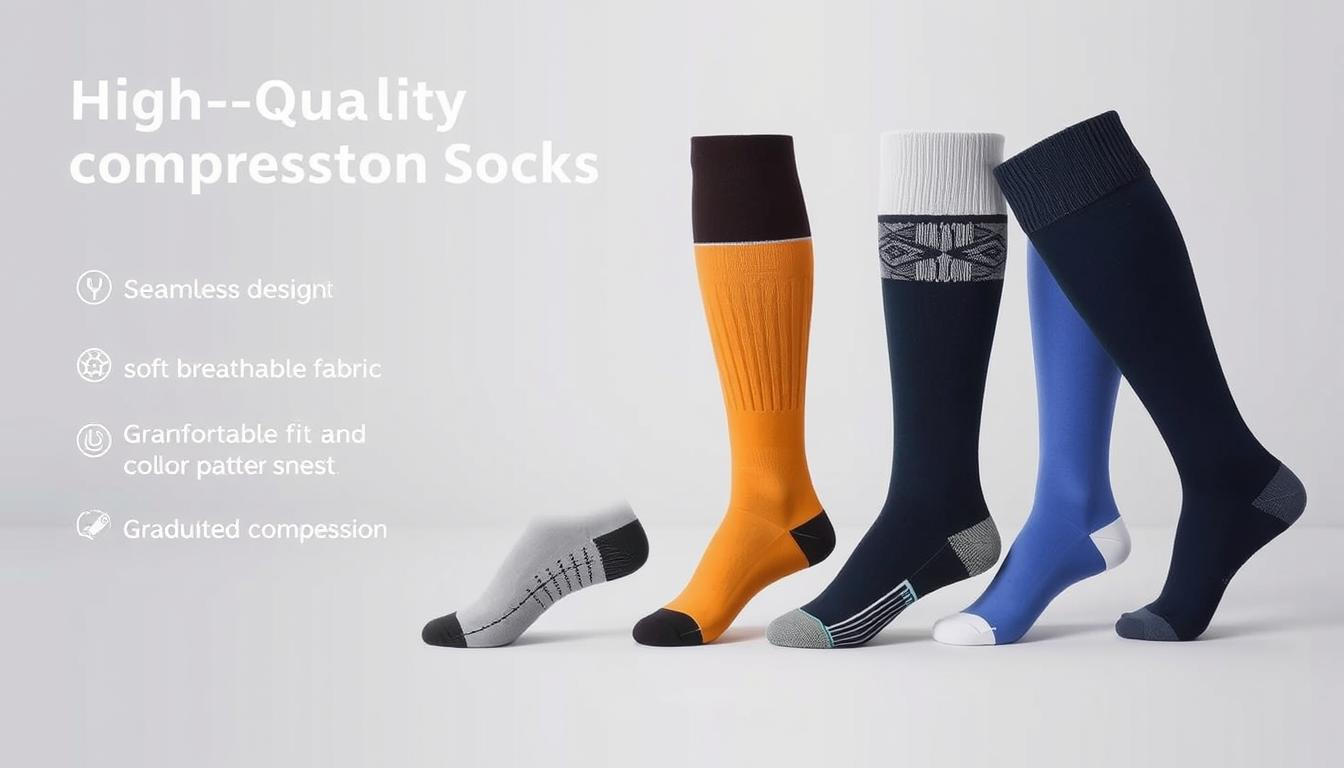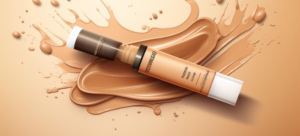Diabetic patients often face issues with poor circulation and swelling in their feet and legs. The right compression socks can help improve blood flow and reduce swelling. This article will look at the top compression sock options for diabetics. We’ll cover the key features, benefits, and how to choose the best fit.
A pair of high-quality compression socks designed for diabetics, featuring a seamless design, soft breathable fabric, and graduated compression style. The socks should be displayed on a neutral background, showcasing their comfortable fit and stylish appearance. Highlight the variety of colors and patterns available, emphasizing their functionality and elegance.
CHECK OUT THE BEST COMPRESSION SOCKS HERE
Key Takeaways
- Compression socks can help manage diabetic foot complications by improving circulation and reducing swelling.
- Choosing the right compression level, material, and fit is crucial for diabetic patients.
- Top compression sock brands offer styles and features tailored for diabetic foot health.
- Proper sizing and care are essential to ensure the effectiveness and longevity of compression socks.
- Consulting a healthcare professional can help determine the appropriate compression level and sock choice for individual needs.
Understanding Diabetic Foot Complications
Diabetes can cause many foot problems, like nerve damage and poor blood flow. These issues make feet more likely to get hurt, infected, or develop ulcers. It’s very important for people with diabetes to take care of their feet. Using diabetic knee high socks and diebetic socks is a big part of that.
Diabetic Neuropathy and Circulation Problems
Diabetes can harm the nerves and blood flow in the feet. This can lead to a lack of feeling and trouble sensing injuries. Also, bad blood flow makes healing slower, raising the chance of infections and ulcers.
The Importance of Proper Foot Care
Getting regular foot checks, keeping feet clean, and wearing the right shoes are key. This includes using diabetic knee high socks and diebetic socks. Daily foot checks, wearing shoes that fit well, and getting quick medical help for foot problems can stop serious issues. It helps keep your feet healthy.
| Diabetic Foot Complications | Symptoms | Potential Consequences |
|---|---|---|
| Diabetic Neuropathy | Numbness, tingling, or loss of sensation in the feet | Increased risk of injuries, infections, and ulcers |
| Poor Circulation | Reduced blood flow, slow wound healing | Increased risk of infections, amputation |
Knowing the risks and taking good care of your feet can help prevent and manage problems. This keeps your overall health and well-being in check.
Benefits of Compression Socks for Diabetics
Compression socks offer many benefits for diabetic patients. They help manage their condition and improve foot health. These socks apply gentle pressure to the legs and feet, promoting circulation and reducing risks.
One key benefit is preventing blood pooling and swelling in the legs. Diabetes can cause poor circulation, leading to fluid buildup and discomfort. Compression socks help by squeezing veins and arteries, improving blood flow.
They also support muscle function and joint mobility. This reduces muscle cramps, fatigue, and other issues. It’s crucial for diabetics, who may have reduced sensation and muscle control due to neuropathy.
Another important benefit is preventing foot ulcers and serious complications. By improving circulation and reducing swelling, these socks help keep feet healthy. This lowers the risk of skin breakdown, infection, and other foot problems common in diabetics.
“Compression socks are a simple yet effective tool in managing diabetes-related foot problems. They can make a significant difference in a patient’s quality of life and long-term foot health.”
Compression socks have many benefits for diabetics. They address circulatory and neuropathic concerns, helping maintain better foot health. This reduces the risk of complications and improves overall quality of life.
How Compression Socks Work
Compression socks are a great help for diabetics. They improve blood flow and prevent foot problems. Their secret is graduated compression.
Graduated Compression Technology
These socks put the most pressure at the ankle. The pressure gets less as you go up the leg. This helps blood flow back to the heart better.
They also stop fluid from pooling in your legs. The pressure is measured in millimeters of mercury (mmHg). Diabetics usually need 15-20 mmHg or 20-30 mmHg socks.
Compression socks fight off diabetic neuropathy. This condition can cause numbness and slow healing in the feet. It also lowers the chance of ulcers and infections.
“Compression socks are a game-changer for diabetics, providing a simple yet effective solution to improve circulation and prevent devastating foot complications.”
Adding compression socks for diabetics to your daily life is smart. It’s a step towards better foot health and overall well-being.
Choosing the Right Compression Level
When picking compression socks for diabetics, the compression level matters a lot. These socks have different levels of compression, from mild to firm. The right choice depends on your specific needs and how severe your circulatory issues or swelling are.
Mild, Moderate, and Firm Compression
Mild compression socks, with 8-15 mmHg, are good for early diabetes compression socks concerns or a bit of swelling. Moderate compression, at 15-20 mmHg, offers more support for those with more serious circulatory problems or swelling. For severe swelling, poor circulation, or advanced diabetic neuropathy, firm compression socks, 20-30 mmHg, are usually recommended.
It’s key to talk to a healthcare expert, like a podiatrist or vascular specialist, to find the best compression level for you. They can check how serious your condition is and suggest the right compression socks for diabetics for your needs.
| Compression Level | mmHg Range | Recommended Use |
|---|---|---|
| Mild | 8-15 mmHg | Early-stage diabetes, mild swelling |
| Moderate | 15-20 mmHg | Advanced circulatory problems, moderate swelling |
| Firm | 20-30 mmHg | Severe swelling, poor circulation, advanced neuropathy |
A close-up view of various styles of compression socks designed for diabetics, showcasing different colors, patterns, and compression levels, displayed on a neutral background, highlighting their texture and functionality.
“Choosing the right compression level is crucial for diabetic patients to effectively manage their circulatory issues and swelling.”
Best Materials for Diabetic Socks
Choosing the right diabetic socks is key. Diabetic feet need special fabrics for comfort and to prevent blisters and sores. The top materials for the best diebetic socks are:
- Cotton – A natural, soft fiber that absorbs moisture and allows air circulation.
- Bamboo – A sustainable, antibacterial option that is gentle on sensitive skin.
- Synthetic blends – Such as nylon or polyester, which offer durability, stretch, and moisture-wicking capabilities.
These fabrics help keep feet dry, reduce friction, and improve circulation. This is important for diabetics to avoid foot problems. Wearing socks made from these materials can make a big difference in comfort and health.
| Material | Key Benefits |
|---|---|
| Cotton | Soft, breathable, and moisture-absorbing |
| Bamboo | Antibacterial, thermoregulating, and sustainable |
| Synthetic Blends (Nylon, Polyester) | Durable, stretchy, and moisture-wicking |
By looking at the materials, diabetics can find the best diabetic socks for their feet.
Top Compression Sock Brands for Diabetics
Several leading brands offer the best compression socks for diabetics. They provide various levels of compression, styles, and features. This helps individuals with diabetes find the right socks to manage their condition.
Brand Comparison and Reviews
Sockwell, Juzo, Medi, and Sigvaris are top brands for diabetic compression socks. They are known for quality, durability, and comfort. These socks support and improve circulation for those with diabetic foot issues.
Sockwell is a favorite among diabetics, offering many styles and colors. Their socks use merino wool for moisture-wicking and temperature control. Juzo is also respected for its medical-grade compression socks, designed for diabetics.
| Brand | Compression Level | Key Features | Customer Ratings |
|---|---|---|---|
| Sockwell | Mild to Moderate | Merino wool, moisture-wicking, temperature-regulating | 4.6/5 |
| Juzo | Moderate to Firm | Medical-grade compression, comfortable fit | 4.8/5 |
| Medi | Moderate to Firm | Graduated compression, breathable fabric | 4.7/5 |
| Sigvaris | Mild to Firm | Customizable fit, wide range of sizes | 4.6/5 |
By looking at compression levels, materials, and features, diabetics can choose the best socks. This ensures they meet their specific needs and preferences.
A collection of compression socks specifically designed for diabetics, showcasing various colors and patterns, arranged elegantly on a soft fabric background, highlighting their soft texture and supportive features, with an emphasis on comfort and medical benefits.
Diabetic Socks for Men
Men with diabetes need special socks. They need socks that wick away moisture and control odors. This keeps their feet dry and healthy.
Look for diabetic socks with reinforced heels and toes. This helps them last longer. A snug fit is also key to avoid slipping or bunching.
- Moisture-wicking fabric to keep feet dry and odor-free
- Reinforced heels and toes for enhanced durability
- Snug, non-slip fit to prevent bunching or irritation
- Breathable, temperature-regulating material
- Seamless design to minimize friction and discomfort
Choosing the right diabetes socks for men is important. Look at the compression level, material quality, and comfort. Good socks help manage foot health and prevent problems.
| Brand | Compression Level | Key Features | Price Range |
|---|---|---|---|
| Sockwell | Moderate | Merino wool blend, reinforced heel and toe | $15-$25 per pair |
| Medi | Firm | Graduated compression, moisture-wicking | $20-$30 per pair |
| Juzo | Mild | Seamless design, comfortable fit | $10-$20 per pair |
Right diabetes socks for men can help. They improve circulation, reduce swelling, and protect feet from damage.
Diabetic Socks for Women
Diabetic women need special socks that are both stylish and functional. They want to look good while taking care of their feet. Luckily, there are now many diabetes socks for women that are fashionable and practical.
Stylish and Functional Options
Compression socks for women are no longer boring. Today, you can find diabetic socks in many colors and designs. Whether you like classic or bold patterns, there’s something for everyone.
Brands now make socks that are both stylish and meet medical needs. They offer breathable materials, seamless designs, and extra support in key areas. This makes them comfortable and effective.
“I love that I can find compression socks that match my outfits and don’t look like they’re just for medical purposes. It’s a game-changer for my confidence and overall foot health.”- Sarah, a diabetic woman.
Looking for something subtle or bold? The selection of diabetes socks for women is vast. With the right pair, diabetic women can stay healthy and stylish.
Proper Sizing and Fit
Finding the right fit is key when looking for compression socks for diabetics. The diabetic compression socks should fit snugly but not too tight. This ensures a comfortable fit that matches your foot and leg size. Always follow the manufacturer’s size guide and get help from a healthcare professional if needed.
To find the perfect fit, consider these tips:
- Measure your feet and legs accurately, taking into account any swelling or changes in size throughout the day.
- Refer to the manufacturer’s size chart and select the appropriate size based on your measurements.
- If you’re unsure, it’s better to size up rather than down to avoid discomfort or restrictive compression.
- Try on the socks and walk around to ensure they feel comfortable and secure without cutting off circulation.
The right fit is crucial for the benefits of compression socks for diabetics. It helps improve circulation, reduce swelling, and prevent foot problems.
| Compression Level | Foot and Leg Measurements | Recommended Sock Size |
|---|---|---|
| Mild (8-15 mmHg) | Ankle: 8-10 inches Calf: 12-14 inches | Small |
| Moderate (15-20 mmHg) | Ankle: 10-12 inches Calf: 14-16 inches | Medium |
| Firm (20-30 mmHg) | Ankle: 12-14 inches Calf: 16-18 inches | Large |
By focusing on proper sizing and fit, you can ensure that your diabetic compression socks provide the greatest comfort and therapeutic benefits to manage your condition effectively.
Caring for Your Compression Socks
Keeping your best diabetic socks or diabetic socks in good shape is key for your foot health. Taking care of your compression socks helps them last longer. This way, they keep supporting and protecting your feet.
Washing and Maintenance Tips
To keep your best diabetic socks in great shape, follow the washing and drying tips from the maker. It’s best to hand-wash or machine-wash them in a gentle cycle. This helps keep their compression strong and prevents damage.
Don’t use hot water, harsh cleaners, or bleach. These can harm the fabric and weaken the compression.
- Hand-wash or machine-wash on a delicate cycle
- Use a mild, non-bleach detergent
- Avoid using hot water or putting the socks in the dryer
- Air-dry the socks to maintain their shape and compression
Storing your diabetic socks right is also important. Keep them in a cool, dry spot, away from sunlight or heat. This helps the fabric stay good and the compression strong.
“Taking care of your compression socks is a simple yet essential step in maintaining their effectiveness and ensuring your feet stay healthy and comfortable.”
By following these tips, you can make your best diabetic socks last longer. This way, they keep giving your feet the support and protection they need.
Conclusion
Diabetic individuals can greatly benefit from using compression socks. These socks provide support and improve blood flow. They help manage common foot problems linked to diabetes.
Looking for the best diabetic socks or compression socks for diabetics? There are many options to choose from. These socks can be a key part of your daily care routine.
By choosing the right compression socks, diabetics can improve their foot health. This can lead to better overall well-being. It’s a step towards managing diabetes and enjoying life more.
FAQ
What are the best compression socks for diabetics?
Diabetics should look for compression socks that offer the right amount of pressure. They should be made from materials that breathe and wick away moisture. Also, they should fit comfortably and be tailored to your needs. Top brands include Sockwell, Juzo, Medi, and Sigvaris.
How do compression socks help manage diabetic foot complications?
Compression socks help by improving blood flow and reducing swelling. This is key for managing diabetic neuropathy and poor circulation. They prevent blood from pooling, support muscles, and lower the risk of foot ulcers and other problems.
What are the different levels of compression for diabetic socks?
Compression socks vary from mild to firm. The right level for diabetics depends on their circulatory issues and swelling. Always talk to a healthcare professional to find the best compression for you.
What are the best materials for diabetic socks?
Diabetic socks are made from materials that are comfortable, breathable, and moisture-wicking. Cotton, bamboo, and synthetic blends like nylon or polyester are top choices. These keep feet dry, reduce friction, and prevent blisters or sores.
How do I ensure I get the right fit for my diabetic compression socks?
Getting the right fit is key for compression socks to work well. They should be snug but not too tight. They should fit comfortably to your foot and leg measurements. Follow the manufacturer’s sizing guidelines and consider getting help from a healthcare professional.
How do I care for my diabetic compression socks?
Proper care is vital for your compression socks to last and work well. Follow the manufacturer’s washing, drying, and storage instructions. Gentle hand-washing or machine-washing on a delicate cycle and air-drying are recommended. This helps keep the socks’ compression and prevents damage.



